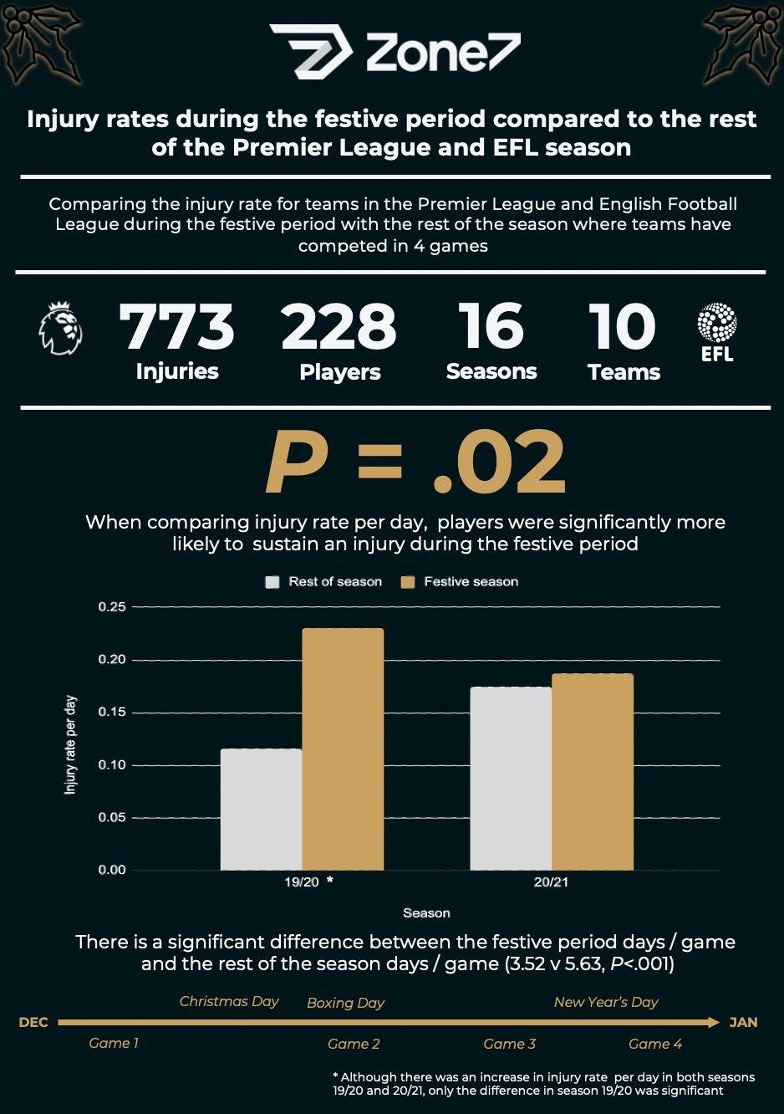The festive period is often bemoaned for its busy schedule. This year, however, provided us with a winter World Cup-imposed break on the typical club fixture calendar that we have become accustomed to. Curious to explore the impact of this usual uptick in match cadence, Data Research Analyst Ben Mackenzie interrogated Zone7’s huge football data lake in search of answers.
In this article Carl Wells, Academy Head of Elite Performance at Sheffield United FC, has taken a closer look at the research comparing the injury rate for the English Premier League and English Football League during the 19/20 and 20/21 festive period compared to the rest of the season.
Wells has a long history of working within elite football environments. Beginning his career at Sheffield Hallam University before becoming Head of Performance at Sheffield Wednesday. He has since worked at The National Football Centre St George’s Park, with the FA, and now with Sheffield United’s academy.

A unique aspect of the English Premier and Football Leagues that contrasts to the majority of Europe is the absence of a winter break during the festive period, with this stage of the season typically characterised by fixture congestion rather than a pause in competition. Historically, such a sharp increase in game density during the season mid-point has been viewed negatively by some coaches, who suggest the lack of recovery time between fixtures is attributed to player burnout and increased injury incidence. The negative consequences of which are felt both acutely and later in the season during European club and national competitions.
Zone7 have taken this assumption further and provided some objective insights regarding the impact of the festive period fixture schedule in England. It is reported that the mean time between games decreased from 5.63 days during the regular season to 3.52 days for the festive period. The cascade effect of a 37% reduction in recovery time between fixtures during late December to early January and sudden elevation in competition load (Gualtieri et al., 2020) would appear to cause a significant increase in injury rate per day when data from the 19/20 and 20/21 seasons are combined (P=0.02).
Interestingly, further inspection reveals the two seasons included in the analysis also differ substantially, with a much higher daily injury incidence occurring during the festive period of the 19/20 than the 20/21 season. Additionally, the 19/20 season has the highest total number of festive period injuries! The cause for such seasonal differences is unclear. A potential spurious factor affecting the accuracy of the research could have been the impact of the Covid pandemic. English clubs had an altered loading pattern towards the end of the 19/20 season, effectively having a late season break imposed by the suspension of league competitions. Was such a recovery period actually positive for player wellbeing as alluded to in the introduction of this article, helping to prevent injuries during the latter 20/21 season festive period? It should also be noted that the England men’s team had their best performance at a major competition for a generation, reaching the final of the 2020 European championships! Further analysis containing more than two time points (seasons) to gain a more accurate understanding of the festive period on injury and performance is required, but the early insights from Zone7 pose worthwhile questions regarding the management of fixture allocations, recovery periods and physical preparation within elite football.
Clubs fortunate enough to have large squad sizes that permit player rotation maybe one method to mitigate the potential negative impact of such periods. However, more controllable variables will be the manipulation of the players conditioning and nutrition in preparation for the festive period. Specifically, a periodised increase in appropriate physical load or achievement of non-negotiable physical exposures such as max speed and deceleration leading into this period may help vaccine the players against the increased physiological demands of fixture congestion.
In summary, the key take home from this Zone7 analysis is that, while strategies to cope with fixture congestion will be club specific, a constant and low hanging fruit for all clubs is to embrace physical prep rather than shy away from conditioning work in readiness for the challenges ahead.
References
Gualtieri, A., Rampinini, E., Sassi, R. and Beato, M., 2020. Workload monitoring in top-level soccer players during congested fixture periods. International journal of sports medicine, 41(10), pp.677-681.
Ready to Elevate your Performance? We provide a comprehensive suite of products and services utilizing data and AI to enable greater performance and durability amongst high-performance teams.
To find out more about our work, Book a Demo today.


